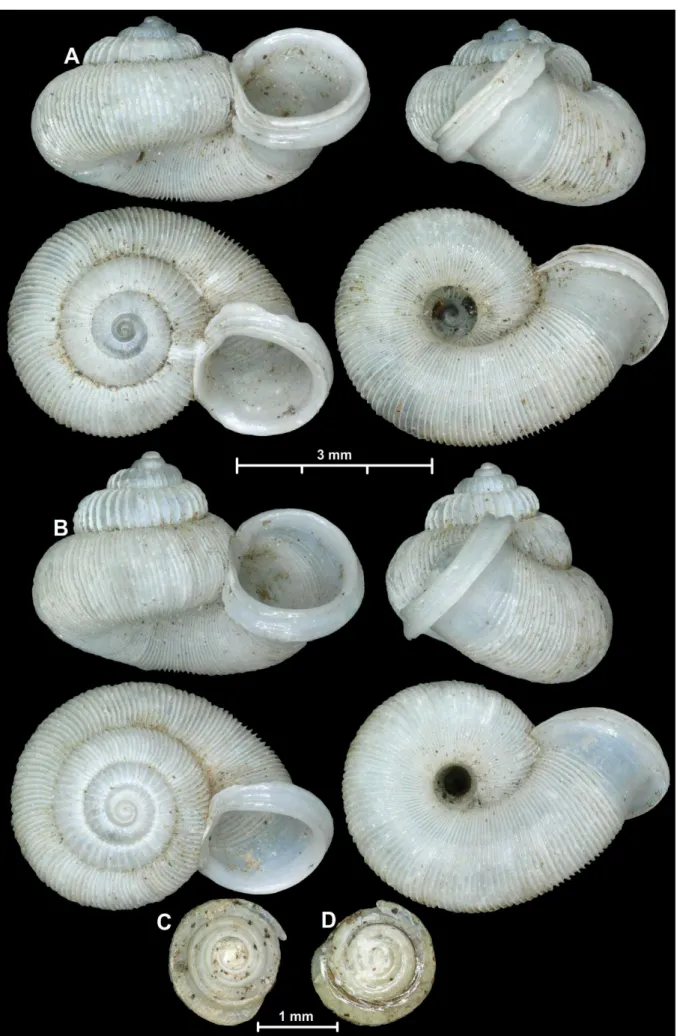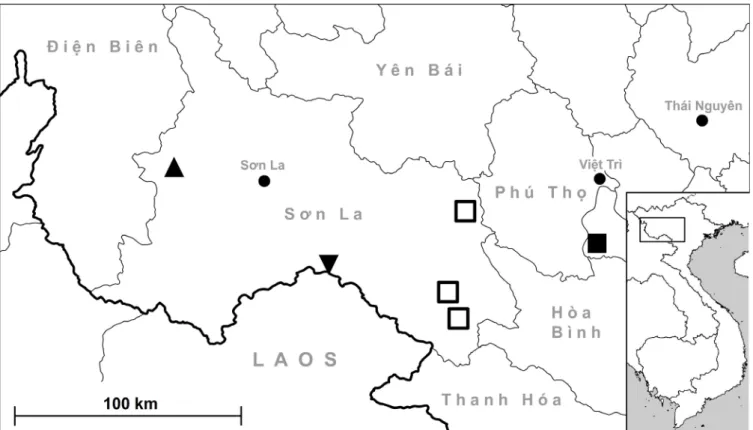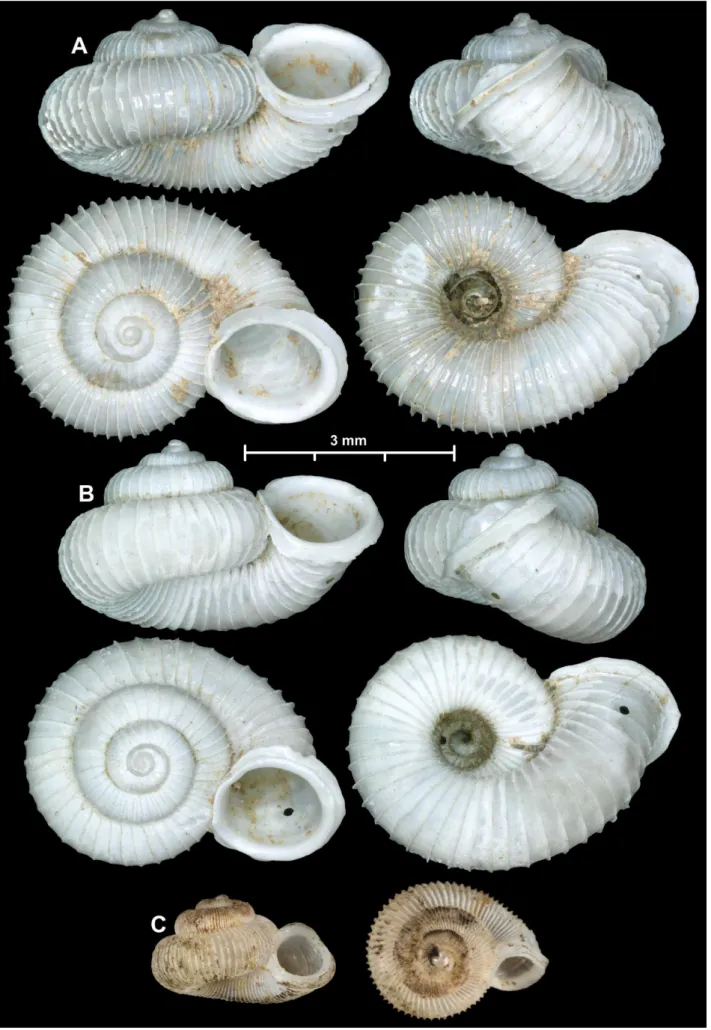Páll-Gergely & Hunyadi: A new species and a subspecies of Laotia
A new species and a new subspecies of Laotia Saurin, 1953 (Gastropoda:
Caenogastropoda: Alycaeidae) from Sơn La Province, Vietnam
Barna Páll-Gergely1* & András Hunyadi2
Abstract. Laotia luongi, new species, and Laotia christahemmenae phami, new subspecies, are described from Sơn La Province, northern Vietnam. The new species is similar to L. christahemmenae in size and shape, but differs from it in the widely-spaced, straight ribs and the presence of ribs behind the peristome. Laotia christahemmenae phami, new subspecies, differs from the nominotypical subspecies in the more elevated spire and narrower umbilicus.
The operculum of Laotia christahemmenae phami, new subspecies, bears an elevated lamina on its outer surface.
This represents the first report of a Laotia operculum.
Key words. taxonomy, systematics, shell, Laos, endemic, Diplommatinidae RAFFLES BULLETIN OF ZOOLOGY 69: 118–123
Date of publication: 7 May 2021 DOI: 10.26107/RBZ-2021-0010
http://zoobank.org/urn:lsid:zoobank.org:pub:DD656B82-2FF6-444F-B259-827EDC7F3715
© National University of Singapore
ISSN 2345-7600 (electronic) | ISSN 0217-2445 (print)
INTRODUCTION
The genus Laotia Saurin, 1953, is a group of small terrestrial caenogastropods (shell diameter: 2.7–5.3 mm), and it is peculiar in having an upturned aperture, which is a rare evolutionary event among terrestrial snails (Páll- Gergely & Neubauer, 2020). The systematic position of this genus is questionable. It has been classified either in the Diplommatinidae or in the Alycaeidae (e.g., Saurin, 1953;
Páll-Gergely, 2014), but this question is not resolved yet and awaits molecular phylogenetic information.
Two species are currently included in Laotia. The type species, Laotia pahiensis Saurin, 1953, is known from northern Laos, whereas the other species, L. christahemmenae Páll-Gergely, 2014, was described from Ba Vi National Park, Hanoi City, northern Vietnam. Both species were known only from their respective type localities until Do et al. (2015) subsequently reported the latter species from Sơn La Province.
Recent investigations in northern Vietnam and central Laos resulted in the discovery of seven Laotia populations. Among them, four are identified as L. christahemmenae, two are here described as a new subspecies of L. christahemmenae distinguished from the nominotypical subspecies by a strongly elevated spire. We also describe a new species, which differs
from L. christahemmenae in the widely-spaced, straight ribs that are also present even behind the peristome.
With the present new species and subspecies, Laotia includes three species and one subspecies, and seems to be endemic to northern Laos and northern Vietnam.
MATERIAL AND METHODS
The counting of the shell whorls (to the closest 0.25 whorl) follows Kerney & Cameron (1979: 13). Ten to 30 photographs were taken of each shell using a Keyence LHX5000 digital microscope and merged to create a single image using Photoshop.
Abbreviations.
D: shell diameter H: shell height
HA: Collection András Hunyadi (Budapest, Hungary) JUO: Collection Jamen Uiriamu Otani (Koka, Japan) MNHN: Muséum National d’Histoire Naturelle (Paris, France)
SMF: Senckenberg Forschungsinstitut und Naturmuseum (Frankfurt am Main, Germany)
VNMN: Vietnam National Museum of Nature (Hanoi, Vietnam)
TAXONOMY AND SYSTEMATICS Family Alycaeidae W. T. Blanford, 1864
Laotia Saurin, 1953 Type species. Laotia pahiensis Saurin, 1953.
Taxonomy & Systematics
Accepted by: Tan Siong Kiat
1Plant Protection Institute, Centre for Agricultural Research, Eötvös Loránd Research Network, Herman Ottó Street 15, Budapest, H-1022, Hungary; Email: pallgergely2@
gmail.com (*corresponding author)
2Adria sétány 10G 2/5., Budapest H-1148, Hungary
Fig. 1. Shells of Laotia Saurin, 1953 species. A, Laotia christahemmenae christahemmenae Páll-Gergely, 2014 (20200210A, VNMN-Z- Inv.000221); B–D, Laotia christahemmenae phami, new subspecies. B, holotype (VNMN-Z-Inv.000218); C, outer side of the operculum,
Páll-Gergely & Hunyadi: A new species and a subspecies of Laotia Laotia christahemmenae christahemmenae
Páll-Gergely, 2014 (Fig. 1A)
Laotia christahemmenae Páll-Gergely, 2014: 291, fig. 3.
Laotia christahemmenae — Do et al., 2015: 120, fig. 2D (new records from Sơn La Province).
Material examined. 8 adult + 13 juvenile shells (coll. HA), Vietnam, Sơn La Province, 27 km ESE from centre of Phù Yên, Mường Do, Han Một Village, ca. 300 m south from the village, 810 m a.s.l., 21°11.731′N, 104°47.129′E (locality code: 2020/7), coll. A. Hunyadi, H.V. Luong, J.U. Otani &
S.V. Pham, 6 February 2020; 1 photographed shell + 1 adult shell + 1 juvenile shell (VNMN-Z-Inv.000221), Vietnam, Sơn La Province, Mộc Châu District, Nȏng trường Mộc Châu, Ngũ Động Bản Ȏn, around the cave, 895 m a.s.l., 20°52.489′N, 104°42.533′E (locality code: 2020/23 and 20200210A), coll. A. Hunyadi, H.V. Luong, J.U. Otani &
S.V. Pham, 10 February 2020; 10 adult + 9 juvenile shells (coll. HA), same data as preceding; 1 adult + 3 juvenile shells (coll. JUO), same data as preceding; 1 broken shell (coll.
HA), Vietnam, Sơn La Province, Mộc Châu District, Vân Hồ, northwestern edge of Pa Cốp towards Bó Nhàng, 980 m a.s.l., 20°46.001′N, 104°45.203′E (locality code: 2020/24), coll. A. Hunyadi, H.V. Luong, J.U. Otani & S.V. Pham, 10 February 2020; 1 broken and corroded shell (MNHN- IM-2012-27224), Central Laos, Luang Prabang Province, ca.
6 km N of Phou Khoun, under rocks in dry secondary forest under and above cliff, 19°29.653′N, 102°24.470′E, 1,244 m a.s.l. (locality code: 34L06), coll. A. Abdou & I.V. Muratov, 16 November 2006 (L. cf. christahemmenae).
Measurements (in mm). D: 4.3–5.2, H: 2.5–2.8 (2020/23);
D: 4.6–5.0, H: 2.6–2.8 (2020/7) (smallest and largest shells of each lot measured).
Distribution. Laotia christahemmenae christahemmenae is known from Ha Noi and Sơn La Provinces in northern Vietnam; its occurrence in Luang Prabang Province of Laos requires verification, see Remarks (Fig. 2).
Remarks. In the original description only a strongly corroded holotype and a paratype with broken aperture were available, therefore the fine sculpture and intraspecific variability of this species could not be properly described. The newly collected specimens agree with the holotype in general shell shape and the absence of ribs behind the peristome;
therefore they are treated conspecific. The holotype had ca.
86 ribs on the last whorl, whereas it was slightly more in most (but not all) shells of the newly examined populations (2020/23: 74–98 ribs/last whorl, n=3; 2020/7: 100–110 ribs/
last whorl, n=3). The rib morphology of the newly collected shells could also be examined. The first ca. 1.5 whorls of the teleoconch possess widely-spaced ribs. The rib density changes rather abruptly to denser ribbing, and remains such until the ribs disappear near the aperture. Ribs (even the ones on the initial teleoconch whorls) are bent in direction of their anterior neighbours (towards aperture), apart from the widely-spaced ribs on the first 1.5 teleoconch whorls the
ribs nearly reaching each other. In case of L. luongi, new species, the ribs are straight.
The single shell from Luang Prabang province in Laos (MNHN-IM-2012-27224) is strongly corroded, its apex and body whorl are broken. It matches with other L.
christahemmenae shells in general shell shape, size, and the absence of ribs behind the peristome. Therefore, until more material becomes available from the same locality, we provisionally identify these shells as Laotia cf.
christahemmenae.
Laotia christahemmenae phami, new subspecies (Fig. 1B–D)
Type material. Holotype (VNMN-Z-Inv.000218, D: 5.1 mm, H: 3.5 mm), Vietnam, Sơn La Province, Thuận Châu District, Co Mạ, Pha Khuȏng, rock wall above Chuyên Nga Motel, 1,270 m a.s.l., 21°21.385′N, 103°31.175′E (locality code: 2020/17), coll. A. Hunyadi, H.V. Luong, J.U. Otani
& S.V. Pham, 8 February 2020.
Paratypes. 1 shell (VNMN-Z-Inv.000219), same data as holotype; 9 shells (coll. HA), same data as holotype; 1 paratype with operculum (photographed), (coll. HA), same data as holotype; 5 adult dead shells (coll. JUO), same data as holotype; 2 adult dead shells (coll. JUO), Vietnam, Sơn La Province, Thuận Châu District, Co Mạ, Pha Khuȏng, along rd. 108, 1,260 m a.s.l., 21°21.36′N, 103°31.4526′E (locality code: 20200208B), coll. A. Hunyadi, H.V. Luong, J.U. Otani & S.V. Pham, 8 February 2020.
Additional material. 1 juvenile shell (coll. HA), same data as holotype.
Differential diagnosis. This subspecies differs from the nominotypical subspecies in the more elevated spire and the narrower umbilicus (umbilicus width ca. one fifth of the small shell diameter in the new subspecies, whereas it is ca.
one fourth in the nominotypical subspecies).
Measurements (in mm). D: 4.9–5.3, H: 3.5 (smallest and largest shells measured).
Operculum. Outer side: funnel shaped with a single, multispiral calcareous lamina bent towards the nucleus.
Inner side: glossy, without central nipple, with shallow, wide spiral grooves corresponding with the position of the elevated lamina of the outer side. This is the first report of an operculum in Laotia.
Etymology. This new species is dedicated to and named after our much-valued friend, Sáng Văn Phạm, who helped during field collection.
Distribution. Laotia christahemmenae phami, new subspecies, is known from two nearby occurring localities in Sơn La Province, Vietnam (Fig. 2). Practically a single population is known.
Fig. 2. Distribution of Laotia Saurin, 1953 species in Vietnam. Triangle: Laotia christahemmenae phami, new subspecies; inverse triangle:
Laotia luongi, new species; square: Laotia christahemmenae christahemmenae Páll-Gergely, 2014 (filled square represents the type locality).
Laotia luongi, new species (Fig. 3A, B)
Type material. Holotype (D: 5.1 mm, H: 2.9 mm) (VNMN- Z-Inv.000220), Vietnam, Sơn La Province, Yên Châu District, Chiềng On Commune, Trạm Hốc Village, Nhả Nhung Cave, around the cave, 970 m a.s.l., 20°59.483′N, 104°11.270′E (locality code: 2020/20), coll. A. Hunyadi, H.V. Luong, J.U.
Otani & S.V. Pham, 9 February 2020.
Paratypes. 5 adult shells (coll. HA), same data as holotype;
8 adult broken shells (coll. HA), same data as holotype.
Additional material. 5 juvenile shells (coll. HA), same data as holotype.
Description. Shell dextral, depressed, 4.25–4.75 whorls; shell shape and size matches L. christahemmenae christahemmenae:
approximately quarter of last whorl turns obliquely upwards;
aperture directed towards apex; protoconch elevated (more elevated than it would be expected from the shell shape), 1.25–1.5 whorls, finely granular, without any notable sculptural elements; teleoconch with widely-spaced, straight, lamella-like, fragile ribs; last whorls with 36–62 ribs (n = 4); area between ribs glossy without spiral lines; rib density constant from initial whorls until the aperture; umbilicus relatively wide, ca. one third of minor shell diameter; aperture rounded; inner peristome slightly protruding, expanded, smeared onto the penultimate whorl; outer peristome strongly expanded, slightly reflected; operculum unknown.
Measurements (in mm). D: 4.3–5.1, H: 2.3–2.9 (smallest and largest shells measured).
Differential diagnosis. In shell size and shape this species is similar to L. christahemmenae. However, the latter species has much denser, bent ribs (straight in the new species) and the area behind the peristome is without ribs (ribbed in the new species). Laotia pahiensis (Fig. 3C) also possesses ribs behind the peristome and has widely-spaced, straight ribs.
Nevertheless, it is much smaller than the new species, and its aperture is less distorted upwards.
Etymology. This new species is dedicated to and named after our much-valued friend, Hào Văn Lương, who helped during field collection.
Distribution. Laotia luongi, new species, is known only from the type locality in Sơn La Province, Vietnam (Fig. 2).
DISCUSSION
Laotia has been classified either in the Diplommatinidae or in the Alycaeidae (e.g., Saurin, 1953; Páll-Gergely, 2014), and was assigned to the latter in the most recent review in the Alycaeidae by Páll-Gergely et al. (2020). Nevertheless, it is distinguished from all other members of that family based on the absence of the sutural tube. The operculum of Laotia is described here for the first time. The multispiral lamina on the outer opercular surface is often found in the Alycaeidae, which may suggest a closer relationship with that family (see Foon & Liew, 2017; Páll-Gergely et al., 2017,
Páll-Gergely & Hunyadi: A new species and a subspecies of Laotia
Fig. 3. Shells of Laotia Saurin, 1953 species. A, Laotia luongi, new species, holotype (VNMN-Z-Inv.000220); B, L. luongi, new species, paratype (coll. HA); C, syntype of Laotia pahiensis Saurin, 1953 (MNHN-IM-2000-28217. Photos: B. Páll-Gergely (A, B), M. Caballer (C, downloaded from the website of MNHN).
2020). The diplommatinid opercula are usually smooth on the outside or are multispiral without elevated lamina (e.g., Yamazaki et al., 2013, 2015; Neubert & Bouchet, 2015).
However, there are rare examples of elevated opercular lamina in the Diplommatinidae as well (Greķe, 2017; Nurinsiyah
& Hausdorf, 2017), therefore this character cannot be used to refute either of the two hypotheses. Further examination will be necessary to infer the taxonomic position of Laotia.
The peculiar feature of Laotia is the upward turning aperture, which is known in a number of terrestrial genera. This trait has been evolved in Eupulmonata at least six times, whereas in terrestrial Caenogastropoda at least three times. The genera with that trait inhabit areas of various environmental conditions. Thus, no direct environmental factors can be associated with the upward turning aperture (Páll-Gergely
& Neubauer, 2020).
ACKNOWLEDGEMENTS
The authors are thankful to Hào Văn Lương, Sáng Văn Phạm, and Jamen Uiriamu Otani for their help in the field.
Alexander Reischütz and an anonymous reviewer corrected the manuscript after the original submission. Philippe Bouchet and Philippe Maestrati allowed access to the collection of the MNHN. This study was supported by the Hungarian Research Fund (OTKA FK 135262) and the Bolyai Research Scholarship of the Hungarian Academy of Sciences to BPG.
LITERATURE CITED
Blanford WT (1864) On the classification of the Cyclostomacea of eastern Asia. The Annals and Magazine of Natural History, Series 3, 13(78): 441–465.
Do DS, Nguyen THT & Do VN (2015) A checklist and classification of terrestrial prosobranch snails from Son La, north-western Vietnam. Ruthenica, 25(4): 117–132.
Foon JK & Liew T-S (2017) A review of the land snail genus Alycaeus (Gastropoda, Alycaeidae) in Peninsular Malaysia.
ZooKeys, 692: 1–81.
Greķe K (2017) Taxonomic review of Diplommatinidae (Caenogastropoda) from Wallacea and the Papuan Region. In:
Telnov D, Barclay MVL & Pauwels OSG (eds.) Biodiversity, Biogeography and Nature Conservation in Wallacea and New Guinea, Volume 3. The Entomological Society of Latvia, Riga.
Pp. 151–316, pls. 19–47.
Kerney MP & Cameron RAD (1979) A Field Guide to the Land Snails of Britain and North-west Europe. Collins, London, 299 pp.
Neubert E & Bouchet P (2015) The Diplommatinidae of Fiji – a hotspot of Pacific land snail biodiversity (Caenogastropoda, Cyclophoroidea). ZooKeys, 487: 1–85.
Nurinsiyah AS & Hausdorf B (2017) Revision of the Diplommatinidae (Gastropoda: Cyclophoroidea) from Java. Zootaxa, 4312(2):
201–245.
Páll-Gergely B (2014) Description of the second Laotia Saurin 1953; a genus new to the fauna of Vietnam (Gastropoda:
Cyclophoroidea). Folia Malacologica, 22(4): 289–292.
Páll-Gergely B, Hunyadi A, Đỗ ĐS, Naggs F & Asami T (2017) Revision of the Alycaeidae of China, Laos and Vietnam (Gastropoda: Cyclophoroidea) I: The genera Dicharax and Metalycaeus. Zootaxa, 4331(1): 1–124.
Páll-Gergely B & Neubauer TA (2020) The value of a single character: the Paleogene European land snail Ferussina Grateloup, 1827 is likely a cyclophorid (Gastropoda, Caenogastropoda). ZooKeys, 918: 29–40.
Páll-Gergely B, Sajan S, Tripathy B, Meng K, Asami T & Ablett JD (2020) Genus-level revision of the Alycaeidae (Gastropoda, Cyclophoroidea), with an annotated species catalogue. ZooKeys, 981: 1–220.
Saurin E (1953) Coquilles nouvelles de l’Indochine. Journal de Conchyliologie, 93(4): 113–120.
Yamazaki K, Yamazaki M & Ueshima R (2013) Systematic review of diplommatinid land snails (Caenogastropoda, Diplommatinidae) endemic to the Palau Islands. (1) Generic classification and revision of Hungerfordia species with highly developed axial ribs. Zootaxa, 3743(1): 1–71.
Yamazaki K, Yamazaki M & Ueshima R (2015) Systematic review of diplommatinid land snails (Caenogastropoda, Diplommatinidae) endemic to the Palau Islands. (2) Taxonomic revision of Hungerfordia species with low axial ribs. Zootaxa, 3976(1): 1–89.


